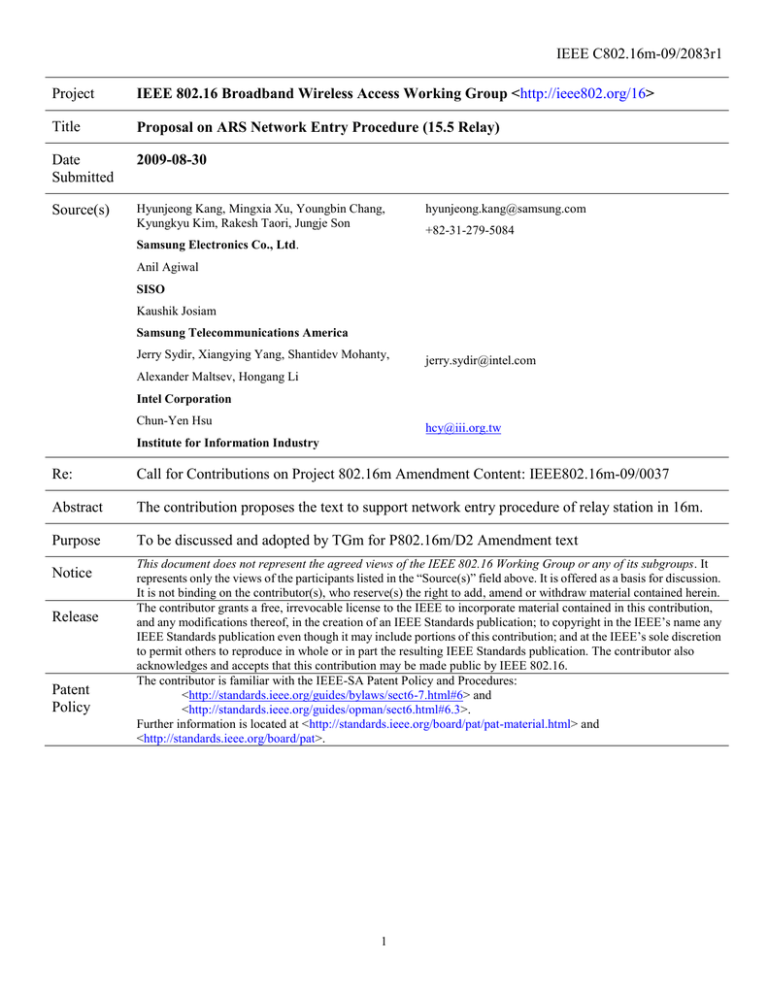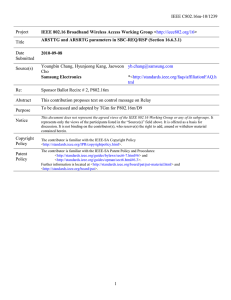IEEE C802.16m-09/2083r1 Project Title
advertisement

IEEE C802.16m-09/2083r1 Project IEEE 802.16 Broadband Wireless Access Working Group <http://ieee802.org/16> Title Proposal on ARS Network Entry Procedure (15.5 Relay) Date Submitted 2009-08-30 Source(s) Hyunjeong Kang, Mingxia Xu, Youngbin Chang, Kyungkyu Kim, Rakesh Taori, Jungje Son hyunjeong.kang@samsung.com +82-31-279-5084 Samsung Electronics Co., Ltd. Anil Agiwal SISO Kaushik Josiam Samsung Telecommunications America Jerry Sydir, Xiangying Yang, Shantidev Mohanty, jerry.sydir@intel.com Alexander Maltsev, Hongang Li Intel Corporation Chun-Yen Hsu hcy@iii.org.tw Institute for Information Industry Re: Call for Contributions on Project 802.16m Amendment Content: IEEE802.16m-09/0037 Abstract The contribution proposes the text to support network entry procedure of relay station in 16m. Purpose To be discussed and adopted by TGm for P802.16m/D2 Amendment text Notice Release Patent Policy This document does not represent the agreed views of the IEEE 802.16 Working Group or any of its subgroups. It represents only the views of the participants listed in the “Source(s)” field above. It is offered as a basis for discussion. It is not binding on the contributor(s), who reserve(s) the right to add, amend or withdraw material contained herein. The contributor grants a free, irrevocable license to the IEEE to incorporate material contained in this contribution, and any modifications thereof, in the creation of an IEEE Standards publication; to copyright in the IEEE’s name any IEEE Standards publication even though it may include portions of this contribution; and at the IEEE’s sole discretion to permit others to reproduce in whole or in part the resulting IEEE Standards publication. The contributor also acknowledges and accepts that this contribution may be made public by IEEE 802.16. The contributor is familiar with the IEEE-SA Patent Policy and Procedures: <http://standards.ieee.org/guides/bylaws/sect6-7.html#6> and <http://standards.ieee.org/guides/opman/sect6.html#6.3>. Further information is located at <http://standards.ieee.org/board/pat/pat-material.html> and <http://standards.ieee.org/board/pat>. 1 IEEE C802.16m-09/2083r1 Proposal on ARS Network Entry Procedure Hyunjeong Kang, Mingxia Xu, Youngbin Chang, Kyungkyu Kim, Rakesh Taori, Jungje Son Samsung Electronics Co., Ltd. Anil Agiwal SISO Kaushik Josiam Samsung Telecommunications America Jerry Sydir, Xiangying Yang, Shantidev Mohanty, Alexander Maltsev, Hongang Li Intel Corporation Chun-Yen Hsu Institute for Information Industry 1. Introduction This contribution proposes a relay station’s operation to enter a network. An ARS begins its operation with network entry procedure. The ARS’s network entry procedure follows the same network entry procedure with AMS with the following additional phases, which are followed after the capability exchange and registration phase: i. Obtain neighbor station measurement report ii. Configure operational parameters 1) Obtaining neighbor station measurement report An serving ABS may request an entering ARS to monitor neighbor ABS/ARS and measure the signal strength of the neighbor stations and report the measurement result during network entry. If the neighbor station measurement report is required, the ‘Neighbor station measurement report indicator’ in AAI_RNG-RSP message is set to ‘1’. When the ARS performs neighbor station measurement and report, it uses the neighbor station discovery and interference measurement mechanism in [2]. 2) Configure operational parameters Before changing to operational mode, an ARS shall obtain the operational parameters and the relay link characteristics to configure itself as a serving access station for an AMS. The operational parameters are provided through a configuration command message. The operation to acquire Relay operational parameters is described in [3]. After the network entry procedure as described above is completed, the ARS enters operational mode. Reference [1] P802.16m/D1, Draft amendment to IEEE Standard for Local and metropolitan area networks Part 16: Air Interface for Broadband Wireless Access Systems, July 2009 2 IEEE C802.16m-09/2083r1 [2] IEEE C802.16m-09/xxxx, Proposal on Relay Station Neighborhood Discovery [3] IEEE C802.16m-09/yyyy, RS operational parameters configuration 2. Suggested remedy ------------------------------- Text Start --------------------------------------------------- [Add the following texts:] 15.5.aa Relay station network entry and initialization The network entry and initialization for relay station follows the procedures defined in 15.3.10. In addition, after the Capability exchange and registration phase, the ARS shall perform 2 addition procedures (phases g and h listed below), i.e. the ARS also obtains neighbor station measurement report and configures the operational parameters as indicated below: a) Scan for DL channel and establish synchronization with the ABS b) Obtain DL/UL parameters (from SuperFrameHeader) c) Perform ranging d) Negotiate Pre-authentication capability e) Authorize ARS and perform key exchange f) Perform Capability exchange and registration g) Obtain neighbor station measurement report h) Configure operational parameters The procedure for initialization of an ARS shall be as shown in Figure XX. 3 IEEE C802.16m-09/2083r1 Scan for A-PREAMBLE Negotiate basic capabilities Neighbor station measurement report Basic capabilities negotiated Neighbor station measurement reported ARS authentication & key exchange Transfer operational parameters ARS authentication complete ARS operational parameters configuration Register with ABS & negotiate remaining capabilities ARS configuration complete Registration & capabilities negotiation complete Operational PHY-level synch with an ABS established Obtain P-SFH/S-SFH IEs P-SFH / S-SFH IEs acquired DL synch with an ABS established Ranging & automatic adjustment Ranging & automatic adjustment complete Figure XX – ARS initialization overview 15.5.aa.1 ABS and ARS behavior during scanning and synchronization An ARS shall follow the same scanning and synchronization procedure as that specified for an AMS. In addition, the ARS may store SA-PREAMBLE and corresponding signal strength information in order to report the stored values to the ABS after registration, by sending an AAI_NBR-MEAS-REP message during the neighbor station measurement report phase upon request. The ABS indicates this request for the information through ‘Neighbor station measurement report indicator’ in the AAI_RNG-RSP message during initial ranging. 15.5.aa.2 ARS neighbor station measurement report The ABS may request the ARS to do neighbor measurements during network entry using the ‘Neighbor station measurement report indicator’ in the AAI_RNG-RSP message. The neighbor station measurement report includes the signal strength and SA-PREAMBLE of neighbor ABS(s) or ARS(s). 4 IEEE C802.16m-09/2083r1 If the measurement is not required, after registration the ARS shall skip the neighbor station measurement report phase and go to the ARS operation parameter configuration phase. The ARS may obtain the neighbor monitoring scheme parameters from a configuration command message. After the configuration command message is sent to an ARS to inform it of the monitoring scheme, the ABS shall not change the frame structure configuration before the ARS enters into operational mode. The ARS shall use the available neighborhood measurement mechanisms defined in 15.5.xx, 15.5.(xx+1), and 8.4.6.1.1.4. The ARS shall then send the measurements to the ABS using the AAI_NBR-MEAS-REP message. This measurement report is used by the ABS to assign the ARS a SA-PREAMBLE based on the report from the ARS. [Insert the following elements in the table 683- parameters for AAI_RNG-RSP in page 51:] Neighbor measurement indicator station Perform Neighbor station Identifies Neighbor station report measurement report if set to ‘1’ measurement report is required during current network entry ------------------------------- Text End --------------------------------------------------- 5


